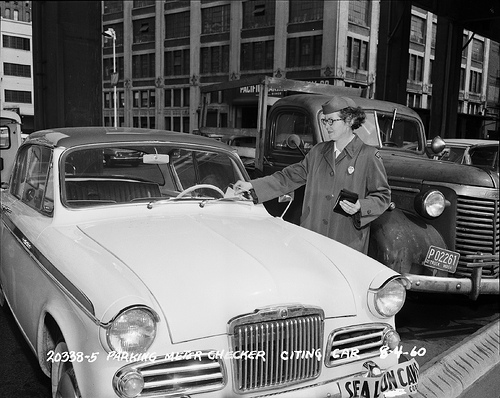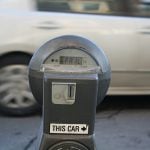Seattle adopts demand-based parking prices
Seattle may soon join the ranks of San Francisco and Los Angeles: cities that have dynamic or time-of-day pricing for its parking network.

Seattle’s parking system is getting an update. From the Seattle Municipal Archives.
The idea stems from Donald Shoup, a professor of urban planning at the University of California, Los Angeles. According to his research on the economics of parking, drivers won’t park at spaces or lots if prices are too high. That behavior negatively affects merchants who depend on curbside traffic for their business, as well as local governments that rely on revenue from meters or publicly owned lots.
If prices are too low, though, Shoup discovered that spaces will fill more quickly, and motorists will leave their cars parked for longer periods of time. Drivers who covet cheaper parking will circle the block, eating up fuel, which has environmental consequences and raises the probability of accidents occurring.
Shoup theorized that, if parking spaces are priced correctly based on demand and time, there should be more of them.
Preliminary data from San Francisco’s implementation of dynamic parking seem to bear out Shoup’s theory. In areas where demand-based pricing was in effect, the city’s targeted range for parking-space occupancy rates — 60-80% in use — rose 31%.
Seattle’s pricing plan will be less complex, partly because parking prices in the city already vary by neighborhood. The difference would then come in rate changes dependent on the time of day.
For example, according to data published by the Seattle Department of Transportation (SDOT) earlier this year, occupancy rates in the core of the Pioneer Square area hover around 53% in the morning. Later in the day, however, that figure jumps to 96%.
So, if dynamic pricing had been implemented at the core and edges of the Pioneer Square neighborhood this fall and summer, SDOT would have proposed variable rates for both areas, the agency said. From 8-11 a.m. in the core area, parking would have been priced at $3 per hour, while the edges would have been priced at $2.50. From 11 a.m. to 6 p.m., however, the price at the core would have risen to $4 per hour, while the edges of the neighborhood would’ve seen the rate increase to $3.50.
The city moved a step closer to implementing these ideas when the City Council Transportation Committee approved last week a plan that would replace 1,500 of Seattle’s parking-pay stations and retrofit 700 of them. Doing so would mean upgrading the kiosks with newer “smart” technology that will allow SDOT to adjust parking rates remotely.
“A lot of the pay stations out there right now are like having a 10-year-old cell phone,” said Mike Estey, SDOT’s manager for parking operations and traffic permits.
The new machines from San Diego-based IPS Group, Inc., will be solar powered. They will also feature alphanumeric keyboards that drivers could use to enter their license plate number for payment. Moving to a pay-by-plate system would do away with the receipts that drivers are currently required to affix to their vehicle windows. Since license plates are keyed to individual vehicles, the feature would also open the door for a pricing system that accounts for vehicle size and emissions.
A pricing system based on vehicle characteristics isn’t on the table for now, though, says Estey. Neither is pay-by-plate. For now, if the full City Council approves the current plan, the upgraded pay stations will be installed in 2015 and 2016 at a cost of approximately $10 million. The estimate does not include installation or operation costs.
Related Posts
Category: Regulations
















